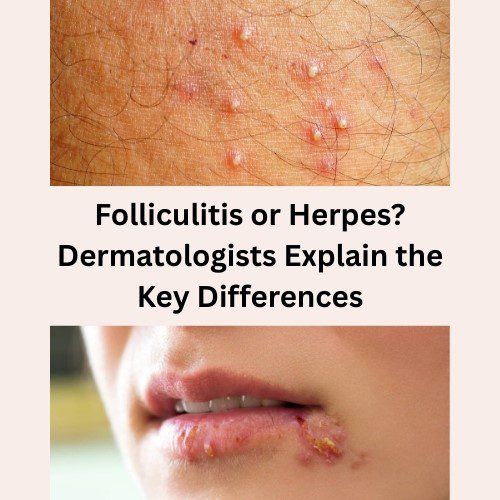Folliculitis is a bacterial, fungal, or irritation-based inflammation of the hair follicles, which leads to red pimples, pustules, itching, and tenderness. It can occur anywhere hair grows, such as the scalp, beard area, chest, legs, buttocks, or bikini area. Because folliculitis often looks like acne or razor bumps, many people confuse it with other skin issues. In mild cases, soothing approaches, including natural options like tea tree oil for folliculitis, are often discussed for their cleansing and calming properties.
Herpes, on the other hand, is a viral infection caused by the herpes simplex virus. It produces clusters of fluid-filled blisters that eventually burst and form painful sores. Unlike folliculitis, herpes is contagious and can recur throughout life. The blisters often appear with warning signs such as burning, tingling, or nerve-like pain before the outbreak begins.
Folliculitis or herpes—these two skin conditions often cause confusion because both can appear as painful, red, or irritated bumps on sensitive parts of the body. Yet despite looking similar at first glance, they are completely different diseases with different causes, risks, and long-term outcomes. Understanding what each condition actually is can help you recognize symptoms early, avoid panic, and choose the right treatment. Some people may even develop complications like inflammation or thickened scars, similar to what is seen in folliculitis keloidalis nuchae explained when discussing chronic follicular irritation.
What Is Folliculitis?
Folliculitis is an inflammation or infection of the hair follicles—the tiny openings in your skin that produce hair. Every part of your body (except palms and soles) contains follicles, which means folliculitis can appear almost anywhere, though the most common sites include:
- Scalp
- Beard area
- Chest
- Back
- Buttocks
- Thighs
- Bikini area
Folliculitis can be mild and temporary, or it can become chronic and recurring. Many people look for solutions such as Natural treatment for folliculitis because the bumps can be itchy, painful, and cosmetically bothersome.
Causes of Folliculitis
Folliculitis occurs when hair follicles become irritated or infected. Common triggers include:
Bacterial Infection
The most frequent cause is Staphylococcus aureus. This bacteria enters the follicle through:
- Shaving cuts
- Excess sweating
- Friction from clothing
- Blocked pores
Fungal Infection
Yeast overgrowth (especially Malassezia) can cause scalp folliculitis or persistent itchy bumps.
Viral Infection
Though rare, some viral infections can mimic folliculitis.
Irritation or Physical Damage
Follicles can also get inflamed without infection due to:
- Tight clothing
- Heavy sweating
- Oil-based skincare
- Hot tubs (leading to “hot tub folliculitis”)
- Waxing or shaving
Ingrown Hairs
Common in people who shave frequently, these hairs curl back into the skin and trigger inflammation.
Symptoms of Folliculitis
Folliculitis symptoms depend on severity, but typically include:
- Small red bumps centered around hair follicles
- Pustules (white-tipped pimples)
- Itching or burning
- Tenderness
- Scabs or crusting when bumps rupture
- Clusters of bumps in areas with friction
Severe cases can lead to deeper infections, painful boils, or scarring.
What Is Herpes?
Herpes is a viral infection caused by the herpes simplex virus (HSV). There are two types:
- HSV-1: Usually causes oral herpes (cold sores).
- HSV-2: More commonly associated with genital herpes.
However, both types can infect any part of the body through skin-to-skin contact.
Herpes is a lifelong condition. After the initial infection, the virus becomes dormant in nerve cells and can reactivate during stress, illness, hormonal changes, or weakened immunity.
Causes of Herpes
Herpes spreads through direct skin contact—often when active blisters are present but also sometimes when the skin appears normal.
Common transmission routes include:
- Kissing
- Oral sex
- Vaginal or anal sex
- Sharing personal items (rare but possible for HSV-1)
Symptoms of Herpes
Herpes symptoms are typically more severe during the first outbreak. Key symptoms include:
- Clusters of clear or yellow-fluid blisters
- Burning or tingling before blisters appear
- Painful, shallow ulcers once blisters pop
- Redness and swelling
- Fever, body aches, or swollen lymph nodes (during first outbreak)
Blisters usually appear in:
- Lips
- Genitals
- Buttocks
- Thighs
- Hands or fingers (herpetic whitlow)
Unlike folliculitis, herpes lesions are not associated with hair follicles and usually form clusters of tiny fluid-filled blisters.
Folliculitis vs Herpes: Key Visual Differences
Although both conditions can produce red, painful bumps, dermatologists highlight several distinctions:
Location of Lesions
- Folliculitis: Always involves hair follicles. Bumps form around or directly on a hair root.
- Herpes: Lesions can appear even where no hair grows.
Appearance of Bumps
- Folliculitis: Red or white pimples, often with a hair in the center.
- Herpes: Tiny clustered blisters filled with clear or yellow fluid.
Sensation
- Folliculitis: Itching or mild pain.
- Herpes: Tingling, burning, or sharp pain.
Progression
- Folliculitis: Bumps may stay as pimples or develop into pustules.
- Herpes: Blisters burst → become ulcers → then scab.
Recurrence Pattern
- Folliculitis: Often triggered by friction, sweat, or shaving.
- Herpes: Triggered by stress, illness, or weakened immunity.
Difference Between Herpes and Folliculitis
Dermatologists summarize the core difference as:
- Folliculitis = inflammation/infection of hair follicles
- Herpes = viral blistering infection
Herpes lesions tend to be extremely painful, shallow, and appear in clusters. Folliculitis tends to look like scattered pimples.
Understanding the difference between herpes and folliculitis is crucial because their treatments are entirely different—antibiotics for bacterial folliculitis, antifungals for fungal types, and antiviral medications for herpes.
How Do I Know if It’s Herpes or Folliculitis?
It can be confusing, but there are clues:
Check for Tingling
Herpes often begins with a tingling or burning sensation before any bumps appear.
Look for Blisters
Herpes almost always forms fluid-filled blisters that later burst.
Check the Hair Follicles
If a hair is in the center of the bump, it’s more likely folliculitis.
Observe the Pattern
Herpes forms grouped clusters; folliculitis forms scattered pimples.
Track Recurrence
Herpes tends to recur in the same location.
For absolute confirmation, dermatologists recommend:
- A swab test (for herpes)
- A bacterial or fungal culture (for folliculitis)
Self-diagnosis can be tricky, so seeking medical advice is always the safest choice.
Folliculitis: Deeper Insight Into the Condition
Since this condition is very common and often mistaken for herpes, dermatologists emphasize understanding its deeper triggers. Below are the types of Folliculitis:
Bacterial Folliculitis
The most common form, caused by bacteria entering damaged follicles.
Fungal Folliculitis
Often itchy and worsened by sweating and humidity.
Viral Folliculitis
Rare, but may occur in immunosuppressed individuals.
Pseudofolliculitis Barbae
Ingrown hairs due to shaving—common in men with curly hair.
Deep Folliculitis (Boils and Carbuncles)
Severe bacterial infection penetrating deeper layers of skin.
Risk Factors
You may be more prone to folliculitis if you:
- Wear tight clothes
- Sweat heavily
- Shave frequently
- Have acne-prone skin
- Use heavy oils or greasy products
- Share razors or towels
Some people also explore herbal options like Fulical – highly effective herbal supplement for folliculitis, especially when dealing with long-term outbreaks.
Herpes: Deeper Insight Into the Virus
Herpes is chronic, meaning the virus stays inside your body permanently. Outbreaks may occur repeatedly, especially during:
- Stress
- Weak immunity
- Illness
- Menstruation
- Excess sun exposure
Stages of a Herpes Outbreak
- Tingling phase – burning or itching
- Blister phase – small fluid-filled bumps
- Ulcer phase – blisters rupture
- Crusting phase – scabs form
- Healing phase
Herpes symptoms typically last 7–14 days.
Why People Confuse Folliculitis and Herpes
Dermatologists say confusion arises because both conditions:
- Can appear around the genitals
- Cause painful or itchy bumps
- May form clusters
- Can recur
However, the root causes, appearance, and treatment differ significantly.
Someone searching for home remedies may come across treatments like natural treatment for folliculitis, which provides relief for folliculitis but would not help with herpes. Likewise, tea tree oil may soothe folliculitis, which is why many people read about tea tree oil for folliculitis, but it would not treat herpes.
Herpes Scarring vs Folliculitis Scarring
While herpes rarely causes scarring, folliculitis can leave dark spots, marks, or thickened bumps—especially if scratched or if the bumps were deep. This is more common in individuals with sensitive or acne-prone skin.
Chronic scalp irritation, for example, leads to thicker scar patches similar to those described in how to prevent and treat this annoying problem when discussing recurring follicular inflammation.
Treating scars depends on the type—pigmentation, textured skin, or thickened tissue. Early treatment helps prevent scars from becoming permanent.
When to See a Dermatologist
Seek medical care if:
- Symptoms worsen
- Blisters appear suddenly
- You have severe pain
- You are unsure whether it’s folliculitis or herpes
- Bumps keep returning
- You develop fever or swollen lymph nodes
Prompt diagnosis prevents complications and helps you get the right treatment quickly.
Final Thoughts
Understanding whether you’re dealing with folliculitis or herpes can feel overwhelming, especially when the bumps appear suddenly and in sensitive areas. But by focusing on the differences—appearance, sensation, triggers, and patterns—you can usually identify which condition is more likely.
Folliculitis is an inflammation of the hair follicles, often triggered by shaving, sweat, or bacteria. Herpes is a viral infection that causes fluid-filled, painful blisters. One is temporary and non-contagious, while the other is long-term and spreads through skin contact.
Knowing these distinctions empowers you to manage your skin better and reduces unnecessary fear. If you ever feel unsure, a dermatologist can confirm the diagnosis through a simple exam or test.
With accurate knowledge and proper care, most cases of folliculitis resolve easily—and even herpes can be effectively managed with the right medical guidance.




